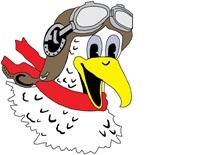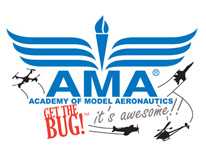Are You New to R/C?
Frequently Asked Questions About R/C Aircraft Modeling
Check out the following questions about radio controlled model aircraft building, flying and general R/C model aircraft questions.
How much does it cost to get started?
Although some of the aircraft can be expensive, a person can get started in the R/C hobby for as little as $150 for a basic electric trainer up to $450 for the top of the line RTF trainer. This is not too expensive when you compare it to the cost of golfing or skiing for a season (about $1800 or more).
Many of those new to RC are starting with Electric powered models because they are for the most part the airplanes are cheaper and it takes less equipment to fly.
How do these miniature aircraft work?
These are miniature aircraft with the same functions as their full sized counterparts. They fly in the same way with the same controls. The big difference is that they are controlled from the ground with a radio transmitter with control sticks on it. The engines can be either 2-stroke or 4-stroke, gasoline or the high end being the jet turbine. Also gaining a lot of popularity is the electric motor . In the aircraft is a radio receiver that runs electric motors called servos. The servos move the control surfaces of the plane causing it to react to the pilot inputs from the transmitter on the ground.
Are they dangerous?
When not treated with due respect and caution, any machine can be dangerous. You must always keep thinking " safety " . We have strict rules and regulations governing the flying of our miniature aircraft. We only fly away from populated areas, and at least five miles away from airports. We are in compliance with rules and regulations of the Academy of Model Aeronautics, and are a sanctioned AMA club.
How do I learn to fly these R/C planes?
Come and attend one of our meetings and our members can help you get started. Another good tool is a flight simulator to practice on, and to get a "feel" for what it's like. One good thing about a simulator is, if you crash it won't cost you any money.
Here are some of the most popular ones on the market: Real Flight , Phoenix R/C 5, AeroFly RC7, and FS One.
Are the models hard to build?
Most of the kits out today can be built with little fuss. If you are capable of following instructions, you shouldn't have any trouble at all. The instructions that come with the kit usually have pictures and diagrams showing you how the parts should go together. Modern model kits are precision cut (laser) and use the best materials. If you have questions about building a kit, there are many experienced model builders in the Club who would be more than happy to lend a hand. There are also a lot of ARF (Almost Ready to Fly) planes available that get you in the air more quickly.
What kinds of tools do I need?
The basic tools include a flat building surface, (a door is good and on top of the door cork or ceiling tile so you can stick your pins in), hobby knife, pins, sandpaper and glue. CA glue (Cyanoacrylate) but watch out DON'T stick your fingers together, it's handy to have a small bottle of DEBONDER handy just in case, and also some epoxy. As you progress in the hobby, you will acquire other tools that help you in your endeavors.
Do I have to build my own model?
Part of the intrigue of R/C modeling is the construction of your own flying machine. Seeing your creation in the air adds to the enjoyment. There are, however, other ways of getting into the air.
In the past few years, manufacturers have been selling ARF's (Almost Ready to Fly) airplanes. Which usually comes 95% built but with no engine or radio or electronics.
They also have RTF trainers (Ready to Fly) They come complete with everything needed to get into the air, including the radio and engine already mounted and ready to Fly out of the box. Although you will still have to buy your basic field equipment and fuel or batteries for about for $100. The major structures have already been built and finished. It only takes a few hours to put it together. The quality and functionality of these models has gone up greatly in the past few years, while the price has come down. The RTF Trainer's in my opinion are really the best route to go for a beginner.
Here are some great examples of RTF (Ready to Fly) Trainers: Hobby Zone Apprentice and E-fliteTimber. These planes come in several sizes from Horizon Hobby. Join a club and get advice from other fliers!
Today, Horizon Hobby offers a number of airplanes by completion level: Ready-to-fly, Bind-N-Fly, Plug-N-Play, Ready-to-Cover, Almost Ready-to-Fly, and Kits.
How fast do they fly?
Their flying speeds can range from about 15 mph to over 200+ mph ( jet turbine). The speed of an average sport model flown in this area from 20 to 50 mph.
How big are they?
A typical sport model or trainer can have about a five foot wingspan and weigh from four to eight pounds. There are single and multi-engined models that can have twelve foot wingspans and weigh twenty pounds or more. Jet turbines have been increasing in popularity. Most models can be disassembled for transportation with the wing being detached from the fuselage.
How long does it take to fly on your own?
That all depends on the student, and how much time an individual can spend with the instructor. A good guess would be three months to a year on the average. The more time (hours) a student can get, the faster (he or she) can fly solo and receive their "wings".
Get started now by taking the free Online RC Airplane Ground School offered by RC Airplane World.com This ground school has a whole lot of great information you need to know. It is a great way to learn a whole lot in a little amount of time. I highly recommend it!

